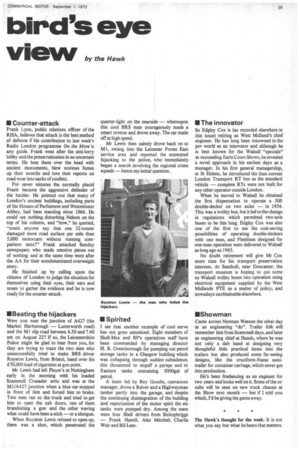bird's eye
Page 45

If you've noticed an error in this article please click here to report it so we can fix it.
view by the Hawk
• Counter-attack
Frank Lyon, public relations officer of the RHA, believes that attack is the best method of defence if his contribution to last week's Radio London programme On the Move is any guide. Frank went after the anti-lorry lobby and the preservationists in no uncertain terms. He beat them over the head with ancient monuments, blew noxious fumes up their nostrils and tore their reports on road wear into sacks of confetti. '
For seven minutes the normally placid Frank became the aggressive defender of the haulier. He pointed out that many of London's ancient buildings, including parts of the Houses of Parliament and Westminster Abbey, had been standing since 1066. He could see nothing disturbing Nelson on the top of his column, and "how," he queried, "could anyone say that one 32-tonner damaged more road surface per mile than 5,000 motorcars without running comparison tests?" Frank attacked Sunday newspapers who made emotive pieces out of nothing and at the same time went after the AA for their unsubstantiated overweight story.
He finished up by calling upon the citizens of London to judge the situation for themselves using their eyes, their ears and noses to gather the evidence and he is now ready for the counter-attack.
• Beating the hijackers
Were you near the junction of A427 (the Market Harborough — Lutterworth road) and the M1 slip road between 6.50 and 7.40 am on August 22? If so, the Leicestershire Police might be glad to hear from you, for they are trying to trace the two men who unsuccessfully tried to make BRS driver Royston Lewis, from Bristol, hand over his £.70,000 load of cigarettes at gun point.
Mr Lewis had left Player's at Nottingham early in the morning with his loaded Scammell Crusader artic and was at the Ml/A427 junction when a blue car stopped in front of him and forced him to brake. Two men ran to the truck and tried to get him to open the cab doors, one of them brandishing a gun and the other waving what could have been a stick — or a shotgun.
When Royston Lewis refused to open up, there was a shot, which penetrated the quarter-light on the nearside — whereupon this cool BRS man courageously made a smart reverse and drove away. The car made off at high speed.
Mr Lewis then calmly drove back on to Ml, swung into the Leicester Forest East service area and reported the attempted hijacking to the police, who immediately began a search involving the regional crime squads — hence my initial question.
• Spirited
I see that another example of cool nerve has not gone unnoticed. Eight members of Shell-Mex and BP's operations staff have been commended by managing director H. B. Greenborough for pumping out petrol storage tanks in a Glasgow building which was collapsing through sudden subsidence; this threatened to engulf a garage and to fracture tanks containing 5000gal of petrol.
A team led by Rey Goodie, operations manager, drove a Myer and a Highwayman tanker partly into the garage, and despite the continuing disintegration of the building and vaporization of the motor spirit the six tanks were pumped dry. Among the team were four Shell drivers from Bishopbriggs — Frank Hamill, Alex Mitchell, Charlie Weir and Bill Lees.
• The innovator
So Edgley Cox is (as recorded elsewhere in this issue) retiring as West Midland's chief engineer. He has long been renowned in the psv world as an innovator and although he is best known for the Walsall "specials" at succeeding Earls Court Shows, he revealed a novel approach in his earliest days as a manager. In his first general managership, at St Helens, he introduced the then current London Transport RT bus as the standard vehicle — complete RTs were not built for any other operator outside London.
When he moved to Walsall he obtained the first dispensation to operate a 30ft double-decker on two axles — in 1954. This was a trolley bus, but it led to the change in regulations which permitted two-axle buses to be this long. Edgley Cox was also one of the first to see the cost-saving possibilities of operating double-deckers with one man, and Fleetlines designed for one-man operation were delivered to Walsall as long ago as 1965.
No doubt retirement will give Mr Cox more time for his transport preservation interests. At Sandtoft, near Doncaster, the transport museum is hoping to put some ex-Walsall trolley buses into operation using electrical equipment supplied by the West Midlands PTE as a matter of policy, and nowadays unobtainable elsewhere.
11111Showman
Came across Norman Watson the other day at an engineering "do". Trailer folk Will remember him from Scammell days, and later as engineering chief at Hands, where he was not only a dab hand at designing very thoughtful little practical items into the trailers but also produced some far-seeing designs, like the cruciform-frame semitrailer for container carriage, which never got into production.
He's been freelancing as an engineer for two years and looks well on it. Some of the results will be seen on new truck chassis at the Show next month — but if I told you which, I'd be giving the game away.
The Hawk's thought for the week: It is not what you say but what he hears that matters.


































































































